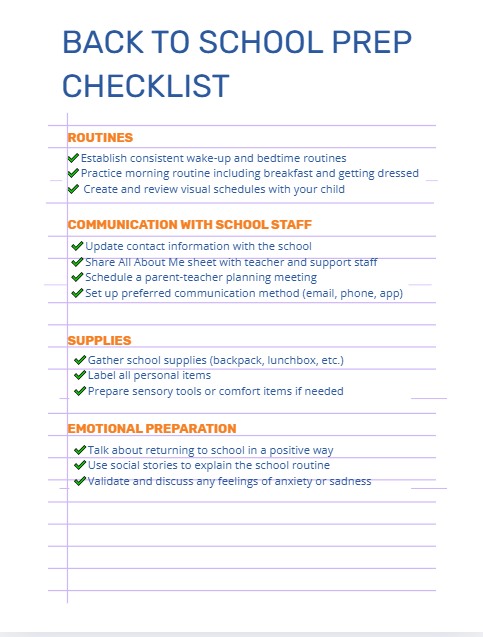
BACK TO SCHOOL SUCCESS
Practical Advice and Tools to Set Your Child Up for a Great Year
Spacer
The start of a new school year brings excitement, anticipation, and a few nerves. For parents and caregivers of children with intellectual and developmental disabilities, this time can feel especially complex. You’re not alone in feelings of anxiety or overwhelm!
The following text provides advice and recommendations for various strategies and tools to use when navigating a new school year.
CREATING ROUTINES AND SUPPORTS
Having a regular routine can make changes easier and help your child feel calm. If your summer schedule has been more relaxed, now is a great time to gently shift back into a school day rhythm.
spacer
🏠 Start with Simple Routines
- Use a morning checklist: wake up, eat breakfast, get dressed.
- Try a visual schedule with pictures or drawings.
- Add sensory supports like quiet time or a favorite fidget.
🌞 Shift Back to School Mode
- Set a regular wake-up time.
- Practice getting ready in the morning.
- Walk to the bus stop at the usual time.
spacer
Don’t be afraid to make it fun! Try doing things like playing “I Spy,” listening to music, and/or tossing a ball while you wait.
🗣 Talk About What’s Coming
Another great way to facilitate this conversation is with social stories! A social story serves an opportunity for a child to walk through the pieces of going back to school and talk about how it makes them think or feel. We’ve attached two great free social stories here, there’s also many that can be found on google. Back To School Social Story, Back to School Social Story for Special Education
Spacer
💬 Support Big Feelings
UNDERSTANDING YOUR CHILD'S NEEDS AT HOME AND SCHOOL
💡 Changes Can Be Tough
🤝 Share What Works
📄 Try an “All About Me” Sheet
- What your child likes and doesn’t like
- Medical needs
- Signs your child is upset and how to help
- How your child communicates
- Your contact info and how you like to be reached
Access our free All About Me Sheets here: All About Me Form – Black and White, All About Me Form – Purple, All About Me Form – Green
COLLABORATING WITH CSE TEAM
🧑🤝🧑 You’re a Key Part of the Team
🗓 Stay Involved and Informed
- Making a list of things to talk about at meetings
- Planning regular check-ins with teachers or staff
- Asking questions if something isn’t clear
TRANSITION PLANNING FOR THE YEAR AHEAD
🎯 Growing Goals for a Growing Child
🧠 Think Ahead
- Summer programs
- Planning for life after high school
- Learning new skills
MOVING FORWARD
💪 You Make a Big Difference
- Use checklists to keep track of tasks
- Try a simple planner for school dates and notes
- Talk with teachers early to stay in the loop
spacer
Together, you and your team can make this school year a confident, joyful, and successful one for you and your child.
Click here to watch a Back-to-School Webinar: Back to School: Preparing for a Successful Year
Also Check Out the Back-to-School Checklist Below:
